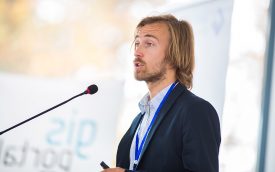Manifesto
Updating Values – FutureDesignEd 2020
Updating Values, the second edition of the FutureDesignEd Symposium – Innovation in Design Education, Innovation in Education by Design, was an opportunity to reflect upon and share priorities and principles in design education in an exchange with experts from 27 Countries.
Educators in the field of design, theoreticians and designers were asked to consider the needs and challenges of future design education. The research that was conducted, the data and case studies that were collected, the papers that were presented, gave rise to 12 points, leading from a focus on the student to an outlook towards the future, 12 points that we wish to share as the legacy of this experience.
They identify values we believe are core to design and design education, cornerstones for a lifelong process of learning and personal and professional growth: aware of the past, open to the future and engaged with the world.
Optimism
Optimism, confidence, outlook towards the future are essential attitudes for a student engaging in the field of design.
Time
Studying means allowing time. The time of learning can be expanded or compressed. The student learns to gauge his/her capacities in intensive design experiences or in more extended projects. Both are necessary.
Experience
“Learning by doing” helps the student understand that he/she can acquire new knowledge through experience in the field, encompassing failure within the process of growth.
Research
The designer needs to shape his/her thinking in a diverse range of contexts, both humanistic and technical-scientific. Research, which is the foundation of cognizant design, gains knowledge from history and from the new.
Growth
The learning process continues over time, allowing for discontinuity, pauses that allow for the sedimentation of knowledge and the student’s growth.
Legacy
Knowledge is also built by listening to the voices of the Masters and engaging with teachers. The plurality within the University and experiences of individual and team work allows the student to address the project from different points of view.
Responsibility
Discussing real problems leads the student to interpret complexity addressing each design decision freely and responsibly.
Involvement
Direct engagement with citizens and other stakeholders in a structured process of collaboration enriches both the project and the student, preparing him/her to contribute to society in the future.
Courage
An ethical approach, receptivity to the new, flexibility towards change, tolerance of personal limits, are values that can help the student handle his/her relationship with tools and technologies that are increasingly interconnected and impact reality.
Curiosity
Embracing multidisciplinarity allows the student to develop the attention and flexibility necessary to face the wicked problems of today, the uncertainties of tomorrow and his/her relationship with an increasingly wide-ranging context.
Openness
Exploring the problems of the future and addressing the goals and guidelines issued by international organizations will develop the student’s capacity for projection and prefiguration that can be pivotal to improving the present.
Passion
Self-learning is an expression of passion towards design studies, and together with formal education, concur to the student’s life-long learning process.
Alessandra Bosco, Università degli Studi della Repubblica di San Marino; Silvia Gasparotto, Università degli Studi della Repubblica di San Marino; Gianni Sinni, Università IUAV di Venezia; Andreas Sicklinger, Università di Bologna; Elena Formia, Università di Bologna; Omar Vulpinari, Università degli Studi della Repubblica di San Marino; Riccardo Varini, Università degli Studi della Repubblica di San Marino; Michele Zannoni, Università di Bologna; Flaviano Celaschi, Università di Bologna; Massimo Brignoni, Università degli Studi della Repubblica di San Marino; Matteo Moretti, Università degli Studi della Repubblica di San Marino; Carmen Ianiro, Università degli Studi della Repubblica di San Marino; Lucrezia Faraci, Università degli Studi della Repubblica di San Marino; Radka Newton, Lancaster University Management School, UK; Piero Formica, Maynooth University, Ireland; Tommaso Bovo, Istituto Europeo di Design – IED Firenze; Angela Grosso Ciponte, University of Applied Science and Arts Northwestern Switzerland, Academy of Art and Design, Basel; Massimo Santanicchia, Iceland University of the Arts; Jonathan Ventura, Hadassah Academic College, Jerusalem IL; Bernard J Canniffe, PIECE Studio and Iowa State University, USA; Audrey G. Bennett, Penny W. Stamps School of Art and Design, University of Michigan, Ann Arbor, USA; Miikka J. Lehtonen, Dubai Institute of Design and Innovation, Dubai, UAE; Qassim Saad, Curtin University, Perth, Australia; Juan Salamanca, University of Illinois, USA; Sergio Brugiolo, Università Iuav di Venezia; Raffaella Fagnoni; Università Iuav di Venezia, Irene Carlino, Università degli Studi della Repubblica di San Marino, Lucilla Cesaroni; Università degli Studi della Repubblica di San Marino; Emanuele Pizzuti, Università degli Studi della Repubblica di San Marino; Katelijn Quartier, Hasselt University (BE); Laura Succini, Università di Bologna; Roberto Paci Dalò, Università degli Studi della Repubblica di San Marino; Andrea Cattabriga, Università di Bologna; Alessio Abdolahian, Università degli Studi della Repubblica di San Marino; Maria Gabriella Milinci, Università degli Studi della Repubblica di San Marino; Francesco Elipanni, Università degli Studi della Repubblica di San Marino; Olga Barmine, Università degli Studi della Repubblica di San Marino; Emanuele Lumini, Università degli Studi della Repubblica di San Marino; Sara Fazzini, Università degli Studi di Trento; Cristina Marino, Politecnico di Torino; Toufic Haidamous, American University in the Emirates; Lorenzo Gerbi, Baltan Laboratories (Eindhoven, NL); Valentina Frosini, P2P Lab affiliate; Monica Pastore, Università IUAV di Venezia; Giovani De Luca, UNESC University, Santa Catarina – Brazil; Francesco Bombardi, Università di Modena e Reggio Emilia; Daniela Piscitelli, Università degli Studi della Campania Luigi Vanvitelli; Gregorio Vaccari, Freelance designer; Tommaso Monaldi, Freelance designer; Hildigunnur Sverrisdottir, UIceland Unuversity of the Arts; Alberto Guerra; Freelance designer.




